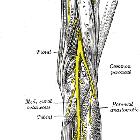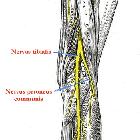peroneus





The common peroneal nerve, also known as common fibular nerve, forms the lateral part of the sciatic nerve and supplies the leg.
Summary
- origin: one of two terminal branches of the sciatic nerve
- course: diverges laterally to enter the lateral compartment of the leg
- terminal branches
- motor supply: short head biceps femoris
- sensory supply: cutaneous innervation of posterolateral leg
Gross anatomy
Origin
One of two terminal branches of the sciatic nerve, with the division typically occurring in the lower-third of the thigh. It arises from the posterior divisions of the anterior rami of L4-S2 nerve roots in the sacral plexus.
Course
Diverges away from the sciatic nerve by sloping lateral and downwards to lie laterally in the popliteal fossa, medial to biceps femoris. It exits the popliteal fossa over the plantaris and lateral head of gastrocnemius. Here the common peroneal nerve remains subfascial as it winds its way around the neck of fibula to enter the lateral compartment of the leg where it can be felt and rolled in the living. It divides into its terminal branches in the peroneus longus muscle - superficial and deep peroneal nerves.
Branches and supply
- peroneal communicating nerve
- pierces roof of popliteal fossa, runs down in the subcutaenous fat, and joins the sural nerve below the gastrocnemius bellies
- lateral sural cutaneous nerve - pierces the roof of the fossa over the lateral gastrocnemius head
- superior and inferior genicular nerves - travel with the arteries of the same name and supply the lateral aspect of the knee capsule
- recurrent genicular nerve
- arises in the substance of peroneus longus, perforates tibialis anterior (supplying its upper lateral fibers) and supplies the capsule of the knee joint and superior tibiofibular joint
- muscular branches - short head of biceps femoris (common peroneal portion of sciatic nerve)
- terminal branches
Relations
- anterior/deep (on posterior aspect of the leg)
- plantaris
- lateral head of the gastrocnemius muscle
- knee joint capsule
- fibular origin of soleus
- anterior/superficial (on anterior aspect of leg)
- peroneus longus
Function
- cutaneous innervation
- lateral sural cutaneous nerve
- supplies skin and deep fascia over the upper half of the peroneal and extensor compartments
- superficial peroneal nerve:
- medial and intermediate dorsal cutaneous nerves supply the skin on the dorsum of the foot
- deep peroneal nerve
- terminal branch gives dorsal digital nerve to supply adjacent sides of the 1st and 2nd toes
- peroneal communicating branch
- joins medial sural cutaneous nerve (from tibial nerve) to form sural nerve that supplies the posterolateral side of the leg and dorsolateral aspect of the foot
- lateral sural cutaneous nerve
- motor supply
- deep peroneal nerve: muscles of the extensor compartment of the leg
- superficial peroneal nerve: muscles of the lateral compartment of the leg
Variants
- the level of division of the sciatic nerve is variable, ranging from its origin at the sacral plexus to the distal femur
- if division of the common peroneal and tibial nerves occurs in the pelvis, the common peroneal nerve may exit the greater sciatic foramen by piercing or passing above the piriformis muscle
- sural communicating branch of common peroneal nerve - absent in 20%
Siehe auch:
- Nervus ischiadicus
- Nervus fibularis communis
- Musculus fibularis quadratus
- common peroneal nerve abnormalities
- Nervus peroneus superficialis
- Nervus fibularis profundus
- Verletzungen Nervus fibularis communis
- Peroneallähmung
- Musculus fibularis longus
- Musculus fibularis brevis
- Musculus fibularis tertius
und weiter:

 Assoziationen und Differentialdiagnosen zu Nervus fibularis communis:
Assoziationen und Differentialdiagnosen zu Nervus fibularis communis:
